The Rapa Nui, the people of Easter Island, thought that they were the last people in the world. Not the only, but the last. You can appreciate why they thought this as you fly to the island. I flew over endless sea, nothing but blue and more blue. Then, just below, there was a green triangle with black sharp cliffs, perfect solitude. The plane flew right out to sea again, swung back and hit the runway at Mataveri airport, on the outskirts of the island’s only town, Hanga Roa.
I’d read Jared Diamond’s Collapse a few years before and had some recollection of stone heads, famine, cannibalism and (obviously) collapse. As I quickly learnt, this isn’t the only interpretation of the island’s history. Thanks to James Grant-Peterkin’s A Companion to Easter Island, I set about learning a different perspective.
Most of us had one of those picture encyclopedias as a child, containing a picture of a huge grey stone head. To look up and see this stone in reality is like seeing Narnia brought to life. The moai (the statues) and the ahu (the platforms on which they stand) were a form of ancestor worship. At some time after the first people arrived in 600ADs, they started building these statues in honour of ancestors who had died and were watching over the community. All were carved without metal tools and transported miles from the quarry to their resting places.
The island was initially covered in palm trees and edible plants. The statues became more elaborate and resources started dwindling: maybe because of rats that had arrived with the canoes eating tree seeds and therefore contributing to increasing deforestation. Wars broke out between the eleven tribes. By the end of the 1700s, the island was desolate. Many of the statutes were thrown down by their own creators or were destroyed by a victorious tribe as a symbol of defeat over their enemy. All moai seen standing today are restorations.
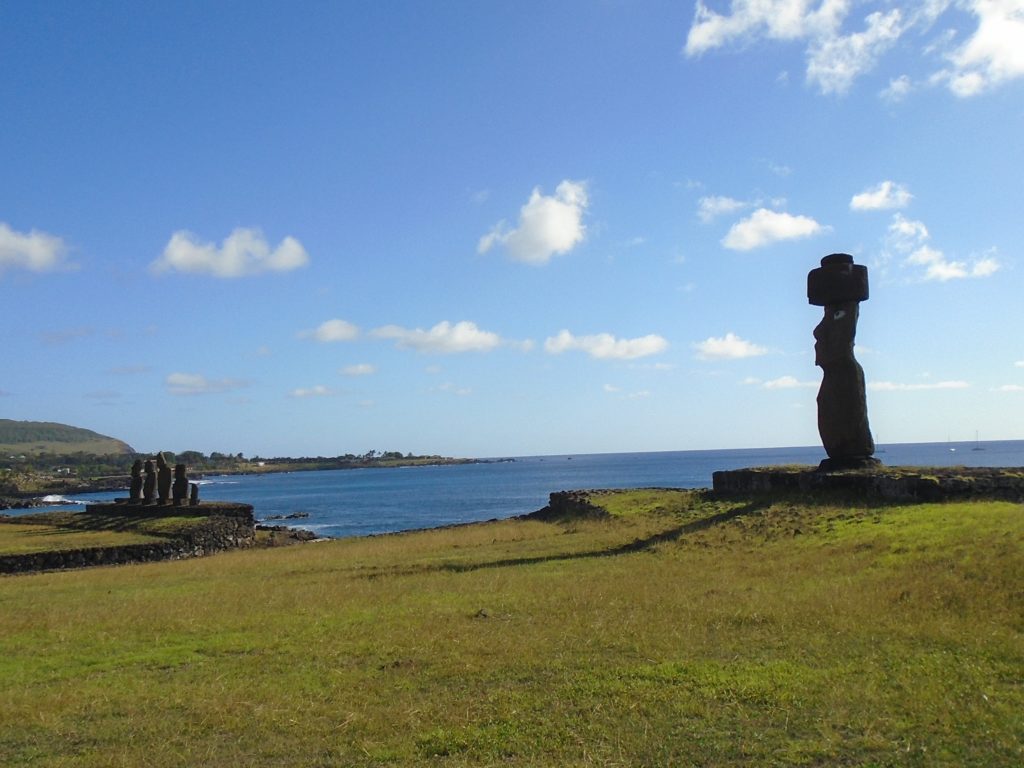
Tahai: Ahu Ko Te Riku on the right 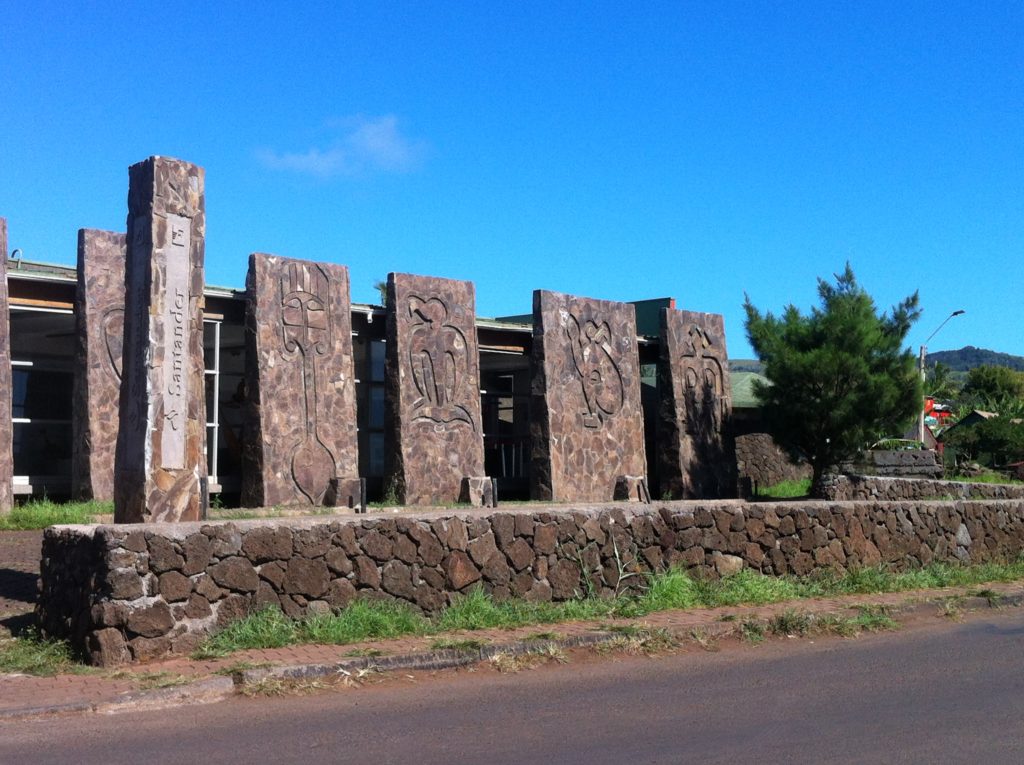
Bank with modern carvings in Hanga Roa
Hanga Roa is serviceable, with understandably expensive grocery shops, carvings outside the main bank and moa hugging Christian crosses in the cemetery. It’s the only place on the island with electricity and running water. I stayed at Hostel Mihinoa, right on a headline with rooms and a campsite, a great choice for its location and lovely welcome at the airport.
The first day I arrived, I explored the moai closest to the town, within easy walking distance at Tahai (just follow the coastline north). There are three restored ahu there. Go at sunset for great photos. The group includes Ahu Ko Te Riku, an impressive single moai with replica eyes and red-stone topknot. The island’s museum is close to this place: I remember it being quite small but housing an original white coral eye which was impressive. The majority of artefacts found on the island are scattered in museums all over the world.
The next place to visit was Orongo, a ceremonial village on top of Rano Kau volcano on the south-west of the island. The whole excursion kept me busy all day. I walked south-west out of town with the sea on my right. I passed Ana Kia Tangata cave: a now-closed cave with rock art fading under the sea spray. After the cave, I followed tsunami evacuation signs, past the CONAF offices and its botanical garden and followed the trail upwards. It’s quite well signposted but if you’re feeling lost, just keep going up 300m of ascent to the volcano rim. The way is shady thanks to the tree plantation most of the way up. Enjoy that shade: you won’t find much more on the island.

The crater is a complex mosaic of mirror water and reeds, a wetland paradise. In 1965, scientists took soil samples from here and found a bacteria used to make Rapamycin, an immunosuppressant drug. I went to see the plaque to this wonder-find (more on the due south side of the crater) but it was missing. Only the lonely headstone remains.
Some time around or after the stone heads were being destroyed, a new religion was born. In that time of violence, warriors and war, the Birdman came into being. Each year, a competition took place with the winning tribe receiving bragging rights, a greater share of resources and tribute. The tribe’s chief became Tangata Manu, the Birdman, the island’s spiritual leader. Each competing tribe chose a champion and walked the path to this volcano to stay in Orongo, a ceremonial village. When the signal was given, the champions raced around the crater to Kari Kari, where the exterior walls drop slightly at the seaward side of the volcano, and scaled down those black giant cliffs. They swam 2km out to sea aided only by para (a sort of hollow reed surfboard that can carry supplies) to reach Mota Nui, the largest of three offshore islands. These islands were the breeding grounds of the sooty tern bird. The champions camped on the island, waiting for the first egg to be laid by the birds. The first man to get his hands on the egg wins and the race is done! A signal was sent to the crowds waiting at Orango in the low, corbelled houses. The winner made his way back with the egg intact in a pouch on his head.
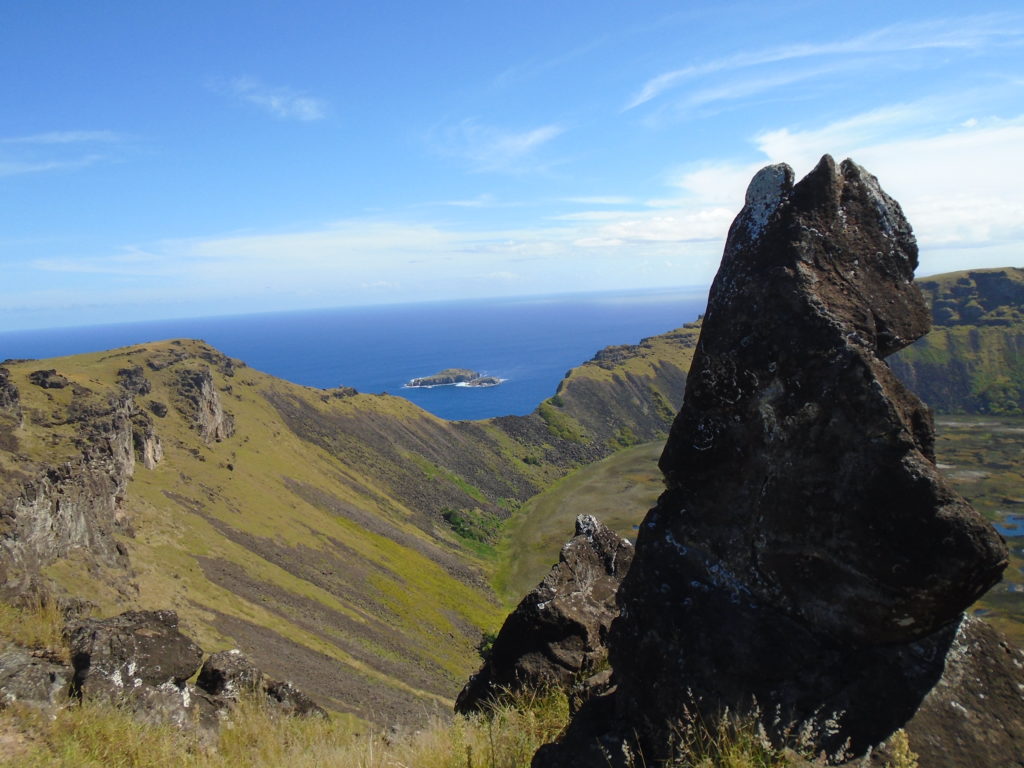
Standing looking at the cliffs and the distant island out to sea, I couldn’t believe how they achieved this feat. The last competition was in 1867. After that, Catholic missionaries came along and put a stop to all this religious inventiveness. But the ruins of Orongo village survive. Some of the houses are reconstructed and I spent a happy time wandering among them. At the edge of the village is Mata Ngara’u: a house with petroglyphs showing the Birdman, the god Make Make and komari (female naughty bits). All are about to fall into the sea from erosion. Some already are hanging on at an angle, looking like they will slip and disappear forever at any moment. Who knows how long they will stay there for people to admire.
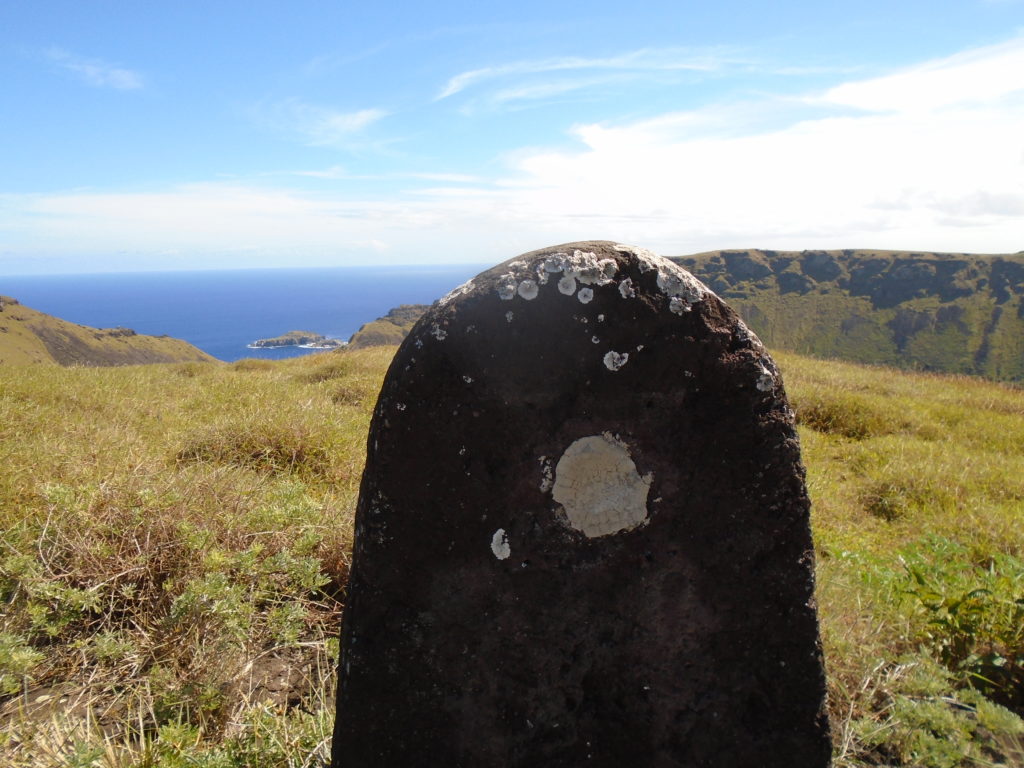
But where is the plaque? 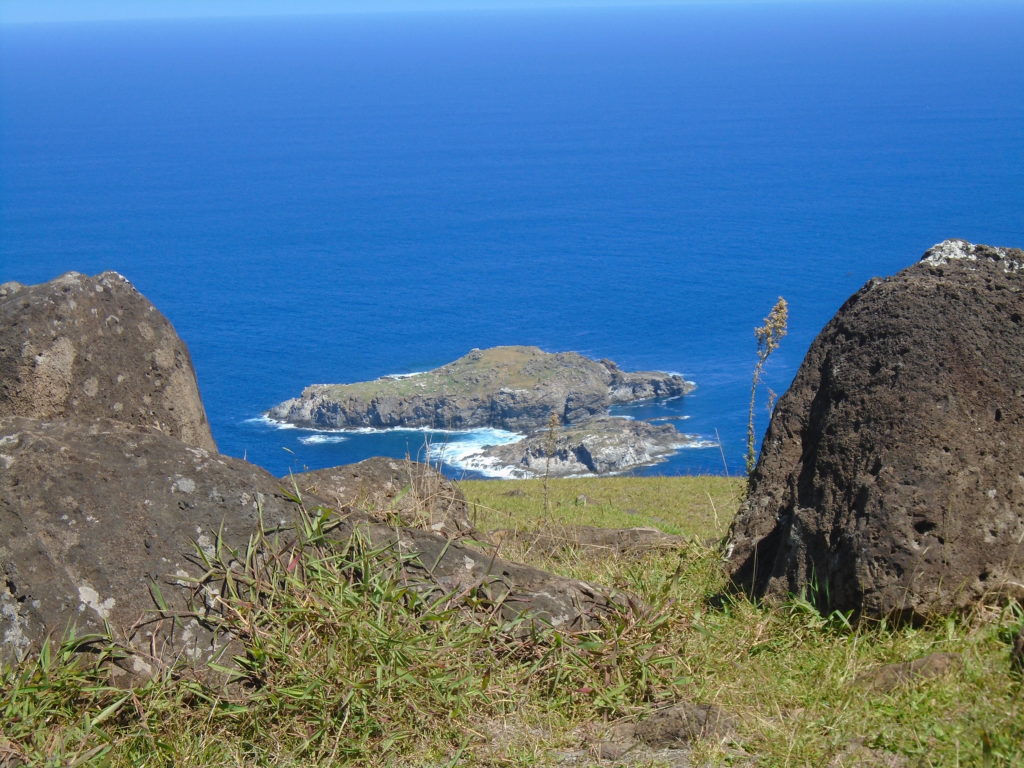
Islands used in Birdman competition 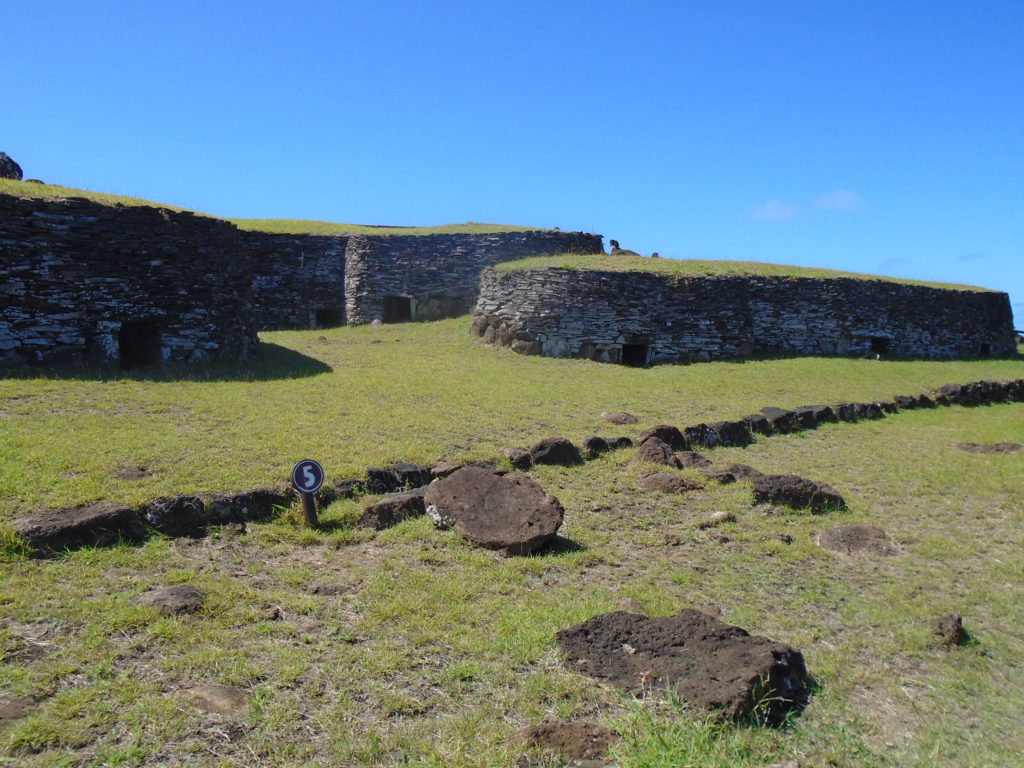
Houses at Orongo
TOP TIPS FOR VISITING EASTER ISLAND
- I was seven days on the island, including arrival and departure days. I left feeling that there were things I still could have explored. If you were seeing the island by organised tour, you could make do with a shorter stay…. maybe…
- Bring your own food if you can and stay somewhere you can cook: food supplies are expensive on the island. That being said, the tuna and cheese empanadas you can buy everywhere are amazing!
- Remember to pay your National Park entrance fee when you arrive at the airport, it may be checked at the larger sites
- You can get around the island by organised tours, private guide, rental car, motorbike or regular bike. I chose to mountain bike (see this post) which was super fun but you could see more with a quicker method of transport
- Make sure to get your Easter Island passport stamp from the Post Office
- Don’t walk on or touch any of the protected sites
- It is hot and sometimes rather windy on the island. Bring sunscreen and an umbrella for shade
- When you are departing, check in for your flight, then leave the airport building and sit by the fence to the north side of the runway (just follow where other people are standing). The plane will fly right over your head as it lands!
One Reply to “All I Learnt on Rapa Nui/Easter Island”